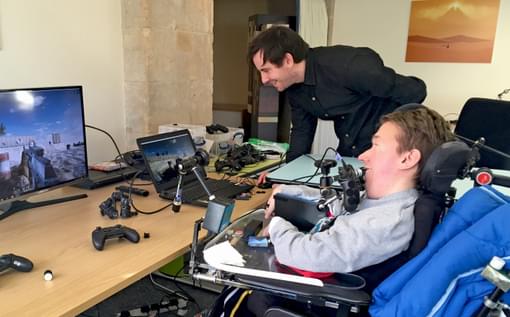SpecialEffect creates unique solutions for gamers living with disabilities
Categories: Chemical and healthcare Technology

In 2018, perceptions of engineers are highly favourable. Engineering is seen to be solving large-scale issues such as energy efficiency, climate change, building infrastructure, and sustainable agriculture. What’s more, engineers are considered highly valuable to the economy. However, while it’s often overlooked, we need to consider that engineering and technology also play a large role on an individual level – particularly for those living with a disability.
As an example of engineering's effects on a more personal, individual level, we sat down with SpecialEffect, a company combining engineering with video games to create unique solutions for gamers living with disabilities.
Can you tell us a bit about SpecialEffect?
SpecialEffect works as a multi-professional team. We use technology to enable people with even the most severe disabilities to enhance their leisure, communication, and control opportunities. Our ‘Loan Library Project’, for example, helps people to play games in a way that matches their needs and abilities. Our aim is to enable them to participate and compete on a level playing field.
Another of our core projects, called ‘StarGaze’, helps people who have had a sudden injury or illness. The project allows the use of eye gaze technology for communication (both face-to-face and online) as well as leisure activities, such as reading, streaming music/films or playing games. As a result of our work with individuals from all over the UK, we use this knowledge and expertise to collaborate with software and hardware developers – designing products that will help severely disabled people on a global scale.
We noticed you’ve had recent success working with Microsoft. How did the relationship start and what design efforts went into creating Xbox’s new adaptive controller?
The Senior Inclusive Designer at Microsoft, Bryce Johnson, first contacted us – introducing the ideas behind the Xbox ‘Adaptive Controller’. From there, we provided online support in the controller’s development and visited the Xbox Accessibility Lab in Seattle to provide feedback and ideas. Other organisations working with disabled people also provided advice too. As more refined prototypes emerged we provided user-based feedback around the inclusivity of the device. In this testing, we aimed to cover the widest spectrum of potential users.
The flexibility of the controller gives people the opportunity to create personalised ways of playing. As such, this allows them to share in the customisation process themselves. Microsoft becoming involved in this field, to this degree, feels like a great step forward for accessible gaming. The awareness raised as a result has helped to bring accessibility to the forefront of gaming.
You’ve recently released free software called EyeMine – can you explain how it works and what it enables?
EyeMine is an interface we created. It enables people – without the dexterity or movement to play Minecraft using standard controllers – to play using an eye gaze camera. Eye gaze is a technology which permits control over your computer using eye movement alone. We designed EyeMine to work with a wide range of eye gaze cameras. Eye gaze systems have inbuilt cameras which track where someone’s eyes are looking, letting users control a PC, for example, by using this tracking information to move the mouse pointer around on the screen. Users can 'click' by either maintaining focus on a target, by blinking, or by using a switch that’s plugged into the computer. EyeMine uses this type of control to play Minecraft.
Our programmer, Kirsty McNaught, co-designed the interface using a fork of the opensource ‘OptiKey’ project. It consists of an on-screen Minecraft-specific keyboard and a few hidden changes using mods to make the game more accessible. To use it, users look at the screen to look in-game. For example, looking towards a tree on the screen will focus on it in the game. Users can then look at the relevant onscreen button to interact further, such as ‘Walk’ to walk towards it or ‘Mine’ to mine it. Depending on the level of accuracy of the gaze control user, there are four versions to use. With less accuracy, buttons are larger and there are fewer options on-screen. With better accuracy, buttons become smaller buttons, and more options become available on the one screen.
What engineering benefits are occurring at an individual level?
A lot of people often associate engineering with mass-scale projects like infrastructure, climate change, renewable energy, AI, and so on. But a career in engineering is certainly not exclusive to that and can play an impactful role on a more personal level. Our work is always very much focused on individual needs and abilities. Our Loan Library Project team, for example, works directly with individuals to create customised control methods that match their individual abilities with the desired games and platform(s). The StarGaze Project meets the urgent needs of people in critical care settings – creating bespoke-gaze-controlled software interfaces matched to their eye gaze abilities.
Tom
Tom, who sadly passed away just over a year ago, was a young man in his twenties with spinal muscular atrophy. He used a PC for his gaming. Tom was a great problem-solver and contributed his own ideas to our technical and therapy teams in our efforts to achieve an optimal software-hardware solution. Tom had a progressive neurological condition that made him become physically weaker over time. When we first visited him, he told us that he hadn’t played ‘FIFA’ for 15 years. We worked in partnership with him to optimise those movements he still had. As a result, Tom was able to take on his brother at FIFA for the first time in years and “hammered him 5-1”.
As his condition progressed further and he became weaker, we continued to make ongoing assessments and support visits to modify his set-up in order to keep him gaming as successfully as possible, for as long as possible. By doing this, Tom managed to keep playing the games he loved until the very end of his life. Of all the positive things that Tom said about having had the opportunity to play again, the one that was most illustrative of the impact of this particular type of assistive technology was what he wrote to us following one of our support visits - “Thank you for giving me my life back.”
Can you tell us about the day-to-day work of an engineer at SpecialEffect?
For us, engineering resides in the constant problem solving we do. We’re constantly creating solutions in order to actually get the technology working. After that, we then work to enable an individual’s use of it. For instance, we may be working with someone who has reduced dexterity in their hands. They want to play a certain game, but can’t press the buttons while also moving two joysticks. In this situation, we would break this down into stages, and create the list of problems to solve.
First, we would see if we could use or emulate the use of one joystick. If the standard resistance of a controller joystick was too much, we would modify it by de-soldering the parts and replacing the spring with a lighter one. We would then try for a second joystick, but, if this were not possible, we’d emulate the directions using accessibility switches. Replacing the buttons on the controller may also require the use of these accessibility switches, as we can position them accessibly, and set the level of resistance to the user’s strength. If restrictions in movement limited physical inputs, we may look at using voice control to emulate buttons – creating software scripts to suit the game and combinations of button presses. Once we have established the core controls for their games, we then work on creating a compatible amalgam for these technologies.
Continued maintenance
Of course, physical abilities and/or games can often change over time. As such, we need to constantly revisit and review an individual’s access. Doing this enables them to control their technology as effectively, comfortably, and successfully as possible. New consoles, software updates, and new games, require new solutions. Creating these solutions forms part of the day-to-day challenges at SpecialEffect. These challenges all need solutions before we can meet the needs of severely disabled people, and meet them in a way that truly optimises their achievements.
EyeMine Links:




